Flower Class Corvette in RN/RCN Service
Part 1: 1941-43
|
The two largest operators
of the Flower Class corvette were the Royal Navy and the Royal Canadian
Navy. During the course of the war the appearance of these ships was to
undergo many changes, some of which are shown here on representative RN/RCN
Flowers.
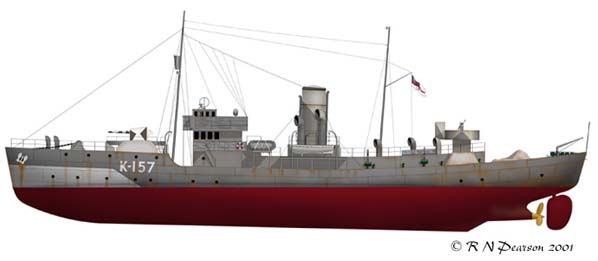
HMCS Dauphin K157
1941
HMCS Dauphin would appear to have been caught while applying her camouflage.
She is in overall medium gray (AP507b) with a white panel on the bow and
gunshield. There are further light gray areas on her bandstand and funnel.
This is the original as-built appearance of the early RCN Flowers. RN
Flowers were similar, but with their bandstand where the mainmast was
sited on RCN Flowers. Secondary armament consists of a pair of Lewis guns
in the bandstand - sufficient quantities of the 2pdr were unavailable.
Also note the original bridge with enclosed charthouse on the upper level,
and the lack of radar.
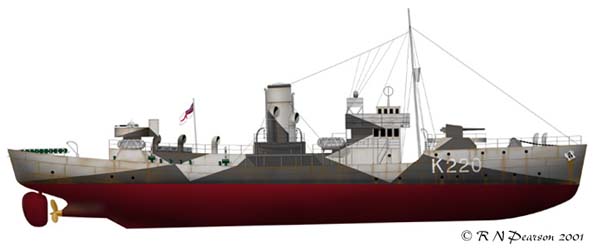
HMCS Midland K220
1942
HMCS Midland is seen here in overall light grey (AP507c) with dark grey
(AP507a) camouflage. Some modification is apparent in that the mainmast
is gone, and the 2pdr has arrived. Her bridge is still of mercantile fashion
and radar is still lacking. Actually by this date there was radar available
to RCN escorts, this was the infamous Canadian designed SW1C .. which,
although a technical achievement in its creation, was totally ineffective
in use. It was to be another year before the vastly superior British type
271 was available to the RCN in any numbers.
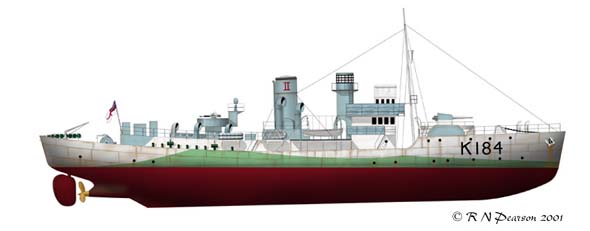
HMS Abelia K184
1942
Tests revealed that rather than the previously used dark colours, the
best shades for the often fogbound north Atlantic were white and various
pastel shades to try and blend the ship into the surrounding murkiness.
To this end, many escorts of the Western Approaches (and other commands)
began to appear in off-white, light blue and light green. These were to
become the classic 'Western Approaches' schemes which dominated the middle
war years.
HMS Abelia is fitted for minesweeping (as were most early RCN corvettes),
and is also fitted with one of the first type 271 radars. However she
still has an enclosed compass house on her bridge.
I have recently found out that her commanding officer in 1943/44 (Lt
O.G. Stuart, RCNVR) was a good friend of a friend of mine, so I would
really love to find a view of Abelia in that period to do an illustration.
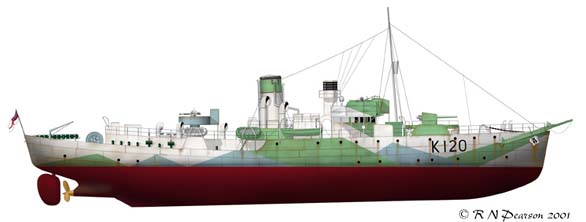
HMS Borage K120
1942
Another Flower fitted for minesweeping is HMS Borage. She, however,
has the 'LL' (magnetic) minesweeping gear on the stern, and an 'acoustic
hammer' on the bow. This was a bucket fitted to the end of of an A-frame
which could be lowered into the water. A weight was dropped into the bucket
setting off a load noise which it was hoped would detonate any acoustic
mines in the area
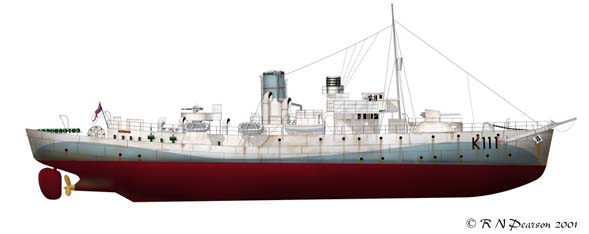
HMS Pennywort K111
March 1942
As well as Abelia, Lt Orme Stuart RCNVR commanded HMS Pennywort between
March-August 1943. I am very interested in finding a photo of her in this
period in order to both profile her, and also build a model. Any help
in this goal would be most appreciated.
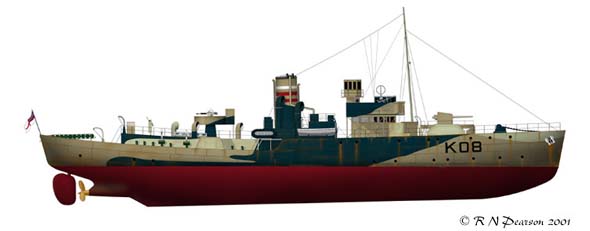
HMS Spirea K08
April 1942
Not all corvettes used the WA colours, and HMS Spirea is a perfect example
of this. She is seen here in MS1, MS4 and MS4a. Her appearance is a mixture
of early and late. .. lengthened foc's'le and radar, but old bridge and
mast.
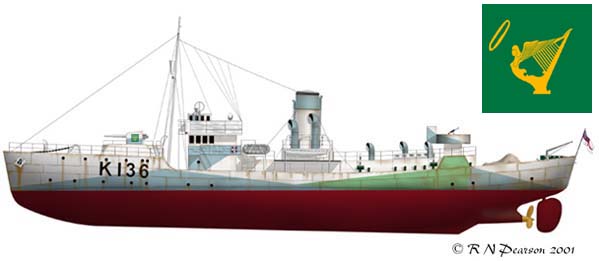
HMCS Shawinigan K136
1942
HMCS Shawinigan wears the classic 'WA" colours. Again, secondary
weapons are negligible. Shawinigan had a gunshield emblem consisting of
a golden harp with a winged female form on a dark green background.
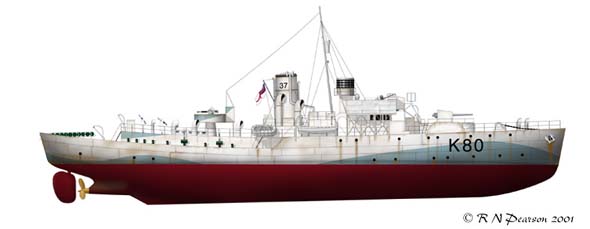
HMS Bluebell K80
1942
Operational experience showed that changes were required to improve
the efficiency of the Flower Class. The most obvious was the extending
of the foc's'le to better accommodate the additional crew required. Other
improvements include a new open bridge with 20mm Oerlikons for defence,
hedgehog anti-submarine mortars, type 271 radar and the mast resited behind
the bridge to improve visibility forward. Bluebell is also carrying two
twin Lewis guns on the aft engine room casing.
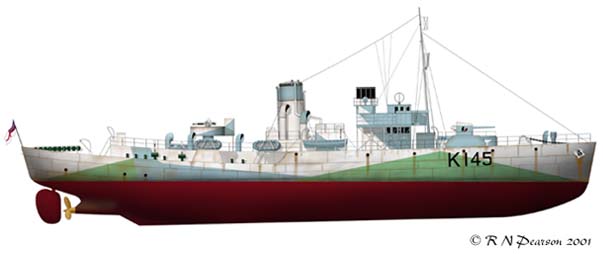
HMCS Arrowhead K145
June 1942
Although the majority of RCN Flowers weren't fully up to RN standards
in mid-1942, there were a handful that were. These were the ten Flowers
that had been built in Canada for the RN, but turned over to the RCN for
the duration .. They retained 'Flower' names rather than the city and
town names given to RCN Flowers (the RCN wanted to call them Town Class,
but that was taken by the 50 four-stack destroyers lent to the RN/RCN
by the USN in return for bases). Arrowhead has almost all of the upgrades
except for Hedgehog and the mast. Arrowhead carried an indian head over
crossed arrows on the gunshield. Indian heads were probably the second
most common form of RCN gunshield art behind Donald Duck.
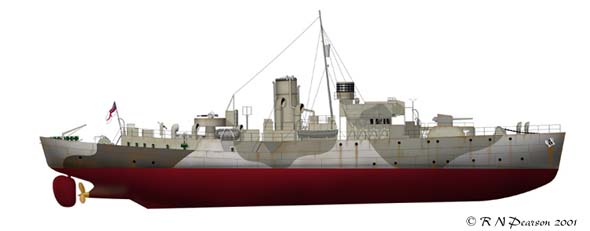
HMS Heather K69
August 1942
Heather is yet another minesweeping corvette as can be seen by the gear
on her stern. Colours are 507A, MS3, 507c and MS4a
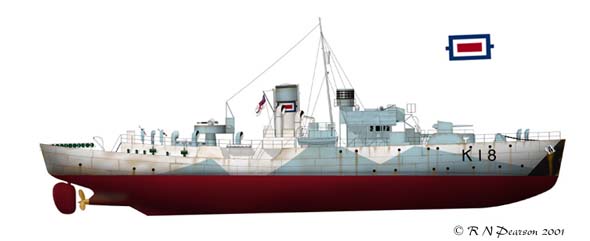
HMS Campanula K18
December 1942
Nicholas Monsarrat, author of "the Cruel Sea" was an officer
on board Campanula. Colours are off-white, WA Blue and black.
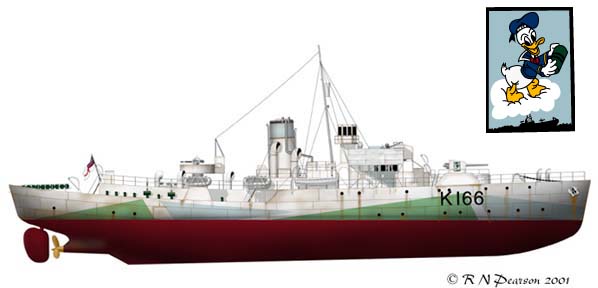
HMCS Snowberry K166
May 1943
Another of the RN ordered RCN Flowers was HMCS Snowberry. She can be
seen in a series of excellent photos in the WR Press volume by John Lambert
on the type. For those who purchased the Revell kit, here is what the
gunshield art SHOULD look like.
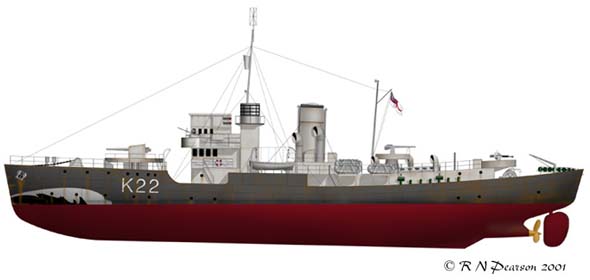
HMS Gloxinia K22
February 1943
Gloxinia was used in the Mediterranean on minsweeping duties (one account
has her leading the main fleet into harbour and setting off a dozen mines
while doing so !!). In common with other Med-based ships she also carried
an additional AA armament in the form of a 4" HA gun in the bandstand
and the 2pdr was resited to the aft end of the engine room casing. Colours
appear to be AP507a hull and 507c upperworks with a white false bow wave.
The bridge is of the earliest form (with an additional level on the compass
house)
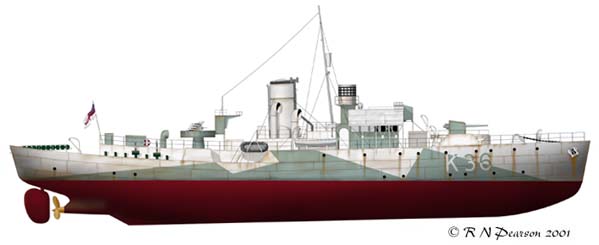
HMS Clematis K36
Early 1943
Clematis shows the next major change in colours, the pastel WA blue
and green were dropped in favour of B55. Interestingly, she has a quad
.50 mount in the bandstand. The 2pdr may not have been the most effective
of weapons, but it was superior to the machine guns fitted.
References
-
Corvettes of the Royal Canadian Navy: MacPherson
and Milner; Vanwell Publishing
-
Canada's Flowers: Lynch; Nimbus Publishing
-
Warship perspective: Flower Class Corvettes: Lambert;
WR Press
-
RN Colour Chips: Snyder & Short Enterprises
-
North Atlantic Run: Milner; University of Toronto
-
Gunshield Graffiti: Lynch, Lamb and Jensen;
Nimbus Publishing
NOTE: I intend to try and illustrate all of the Flower Class corvettes,
and to that end I welcome correspondence with others interested in them,
whether it be a correction or just a comment. This will be a long term
project for eventual publication in some form along with other Allied
escorts.
|













